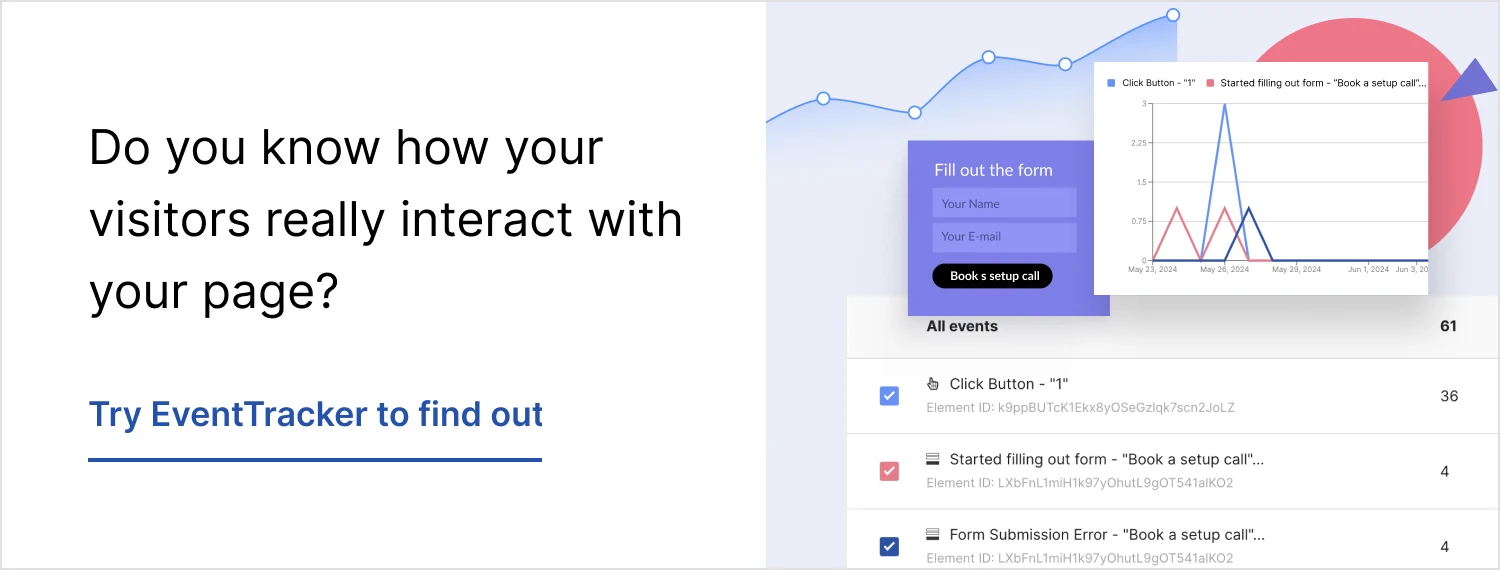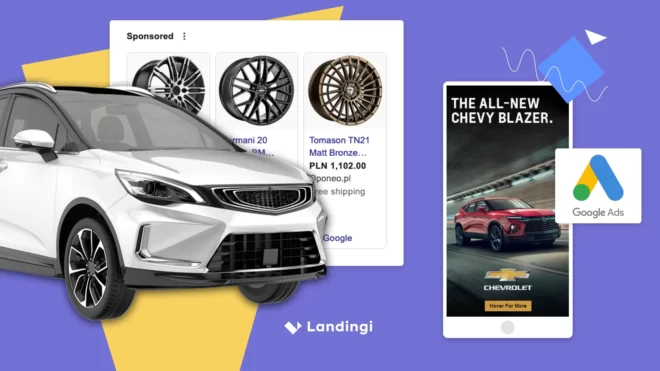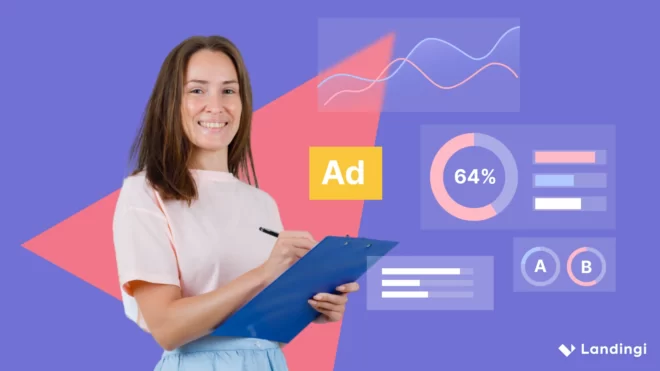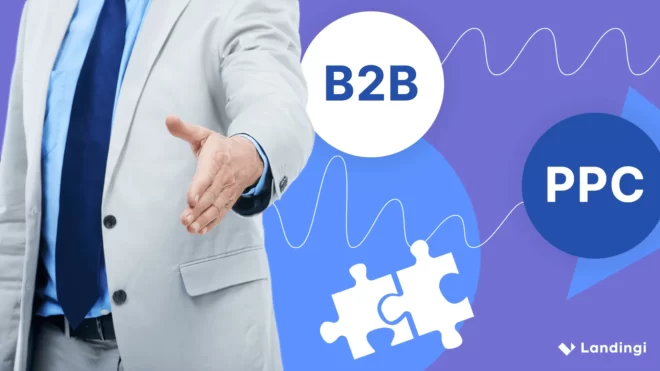Pay-per-click (PPC) advertising is a powerful marketing tool, especially in the automotive industry, where competition is tough and customer journeys have shifted to the digital platform. PPC allows automotive businesses to target specific audiences precisely, ensuring that their advertisements reach potential customers actively searching for vehicles, their components, or services. By paying only when someone clicks on the ad, automotive companies can control their marketing budgets while maximizing the impact of their campaigns.
One of the most effective tools for optimizing PPC campaigns in the automotive sector is Landingi. The platform provides a comprehensive landing page builder that simplifies the creation of high-converting landing pages tailored to PPC campaigns. With its user-friendly interface and robust features, such as the A/B testing tool, EventTracker solution for tracking user behavior, and form builder, Landingi helps automotive marketers design pages that capture leads, showcase inventory, and drive sales. Still, planning and executing great PPC campaigns requires a thorough understanding of the automotive market, careful planning, and continuous optimization.
Reading this article, you will learn the best PPC strategies and meet the perfect tools designed to streamline driving successful campaigns. Scroll down to find the best practices from real-life automotive PPC campaign examples and follow our guide to achieve the best results.
Key takeaways:
- PPC advertising in the automotive industry allows dealerships and auto service providers to achieve greater visibility in search results, directly reaching potential customers actively searching for vehicles, parts, or automotive services. This results in increased website traffic, giving faster results than organic search strategies.
- A successful PPC campaign requires strategic keyword selection and compelling ad copy. Optimized landing pages, created using tools like Landingi, are crucial for driving higher engagement and conversions by providing a seamless and engaging user experience tailored to automotive consumers.
- Various automotive businesses, from car dealerships to repair shops, parts retailers, rental services, and auto insurance companies, can benefit from PPC advertising. Each can target specific customer demographics and services to attract new leads and clients.
- PPC advertising is cost-effective, as businesses only pay when someone clicks on their ad. It also offers measurable results, allowing businesses to track performance in real-time and adjust their strategies for better outcomes, such as increased visibility and lead generation.
- Ensuring compliance with advertising regulations and maintaining transparency with customers is essential. This includes clear communication about prices, promotions, and terms of service, as well as adhering to industry standards and guidelines.
- Regularly reviewing and optimizing PPC campaigns is critical. This involves tracking performance metrics, conducting A/B testing, and staying updated with the latest trends in PPC advertising to improve and adapt strategies for better performance and ROI continually.

What Is PPC Advertising in Automotive?
PPC advertising in the automotive industry is a digital marketing strategy where businesses pay a fee each time their ad is clicked. This model allows automotive companies, including dealerships, repair shops, and parts retailers, to target potential customers searching for specific vehicles, services, or parts online.
PPC ads appear on search engines, social media platforms, automotive websites, and other online platforms, offering precise audience targeting and measurable results. Using strategic keywords and compelling ad copy, PPC advertising helps drive traffic, generate leads, and increase sales, providing a cost-effective way to reach and engage a highly targeted audience.
Each PPC should direct users to a specific landing page, so optimizing your PPC page is crucial in achieving high conversions and increasing ROI. Using the best landing page builder, Landingi, you can design your PPC landing page, test its various versions, and track user behavior to find the most effective layout. Landingi is designed to simplify crafting well-performing landing pages and optimizing them, providing you with great results faster.
Who Should Use PPC in Automotive?
PPC advertising can benefit a wide range of automotive businesses, including car dealerships, repair shops, parts retailers, car detailing services, and everyone in the automotive field who wants to expand online reach. The key automotive businesses that should use PPC include:
- Car dealerships – they can use PPC to attract potential buyers looking for specific brands and models by promoting special offers, financing options, and dealer services. This applies to both new car dealerships and those that offer used cars.
- Auto repair shops – these service providers can target customers looking for specific services like oil changes, brake repairs, or general maintenance, helping to increase appointment bookings.
- Parts retailers – businesses selling auto parts and accessories can use PPC to reach customers looking for replacement parts, performance upgrades, or specialty items, driving online and in-store sales.
- Auto rental services – such companies can attract travelers and locals needing temporary vehicle rentals by targeting keywords related to car rental services, locations, and competitive rates.
- Auto insurance providers – they can use PPC to target drivers seeking new insurance policies, promoting competitive rates, coverage options, and benefits.
- Car wash and detailing services – these businesses can attract local customers who are searching for convenient, high-quality car cleaning and detailing services.
- Mechanics schools – educators can use PPC to reach prospective students interested in careers in auto mechanics, repair, and maintenance.
- Vehicle financing services – companies providing auto loans and financing can target potential buyers needing financial assistance to purchase vehicles, promoting loan options and competitive interest rates.
What Are the Benefits of Using PPC Advertising for Automotive?
PPC advertising in the automotive field provides benefits, helping businesses reach their target audience effectively and achieve their marketing goals, including:
- Increased visibility – as PPC ads appear at the top of search engine results pages and across social media platforms, driving well-structured campaigns lets automotive businesses gain maximum visibility among potential customers actively searching for vehicles, parts, or services.
- Targeted advertising – PPC advertising allows precise traffic targeting based on keywords, demographics, location, and user behavior. This ensures ads are shown to the most relevant audience and increases the chances of attracting qualified leads.
- Cost-effective marketing – with PPC, businesses only pay when someone clicks on their ad, making it a cost-effective way to drive traffic. Its unique pay-for-performance model helps manage budgets effectively and maximize ROI.
- Quick results – unlike organic search strategies, PPC campaigns can generate immediate results, as they appear to potential customers once they are live, which leads to faster lead generation and sales.
- Measurable results – PPC platforms like Google Ads provide detailed analytics and reporting so businesses can track click-through rates (CTR), conversion rates, and cost-per-click (CPC). It allows for data-driven decision-making and continuous optimization.
- Flexibility and control – PPC campaigns offer flexibility in terms of budget, ad copy, and targeting options. Automotive advertisers can quickly adjust their strategies based on performance data, seasonal trends, or inventory changes.
- Brand awareness – even if users don’t click on the ads, they still see the brand name, increasing brand awareness and recognition. This is especially beneficial for new automotive businesses.
- Local marketing – for automotive businesses targeting local customers, PPC ads can be geo-targeted to specific regions, cities, or neighborhoods, ensuring the marketing efforts reach the right local audience.
- Enhanced engagement – PPC ads can include engaging features such as call buttons, site links, and promotional offers, encouraging users to take immediate action.
10 Key Strategies for Successful Automotive PPC Campaigns
While preparing PPC campaigns in the automotive field, consider key strategies to achieve the best results and increase ROI, involving keyword selection, copy creation, landing page optimization, continuous testing, and metrics tracking. The 10 key strategies for successful automotive PPC campaigns include the following:
#1 Strategic automotive keyword selection
The first key strategy for a successful automotive PPC campaign is strategic keyword selection. Identify keywords that potential customers use when they are ready to make a purchase or book a service, such as “buy new cars,” “car repair near me,” or “best car deals”. Use proper high-intent keywords to ensure your ad resonates with your target audience. Focus on long-tail keywords that are more specific and less competitive. These often have higher conversion rates because they capture users closer to the decision-making stage.
#2 Compelling ad copy creation
The second key strategy for a successful automotive PPC campaign is compelling ad copy creation. Highlight unique selling points (USPs) – emphasize what sets your dealership or service apart, such as special offers, financing options, or exceptional customer service. Don’t forget to use clear and persuasive CTAs to encourage immediate action.
#3 Landing page optimization
The third key strategy for a successful automotive PPC campaign is landing page optimization. As each PPC ad directs to a specially crafted landing page with a single purpose, ensure that its content aligns with the ad copy, providing a seamless experience for the user. For instance, if the ad promotes a specific car model, the landing page should feature that model prominently. Focus on creating clean, easy-to-navigate landing pages with fast load times and mobile optimization. Tools like Landingi can help design high-converting landing pages tailored to automotive campaigns.
#4 Geotargeting and local SEO optimization
The fourth key strategy for a successful automotive PPC campaign is geotargeting and local SEO optimization. Use geotargeting to show ads to users in specific locations, such as cities or neighborhoods where your dealership or service center is located. Incorporate location-based keywords in your ads and landing pages to attract local customers, enhancing relevance and boosting local search performance.
#5 Ad extension usage
The fifth key strategy for a successful automotive PPC campaign is ad extension usage. In automotive PPC, this strategy can enhance visibility and highlight special offers. Provide additional information and links, such as site links, call buttons, location extensions, and reviews. This can improve ad visibility and click-through rates. Highlight special promotions, discounts, or limited-time offers directly in the ad extensions to attract more clicks and conversions.
#6 Budget management
The sixth key strategy for a successful automotive PPC campaign is budget management. It’s crucial to set limits so your marketing strategy fits your budget plan. Determine a budget that aligns with your marketing goals and monitor spending closely to ensure you stay within limits. To maximize ROI, use rate adjustments to increase bids for high-performing keywords and decrease bids for those with low performance.
#7 Performance tracking and analytics
The seventh key strategy for a successful automotive PPC campaign is performance tracking and analytics. Leverage tools like Google Analytics and PPC platform analytics to track key metrics such as click-through rates (CTR), conversion rates, and cost-per-click (CPC). Regularly review campaign performance – monitor and analyze campaign data to identify trends and areas for improvement.
#8 A/B Testing
The eighth key strategy for a successful automotive PPC campaign is A/B testing. To find an automotive ad version that resonates best with your target audience, test different ad elements, like headlines, descriptions, images, and CTAs. A/B testing lets you quickly determine which combinations yield the best results based on actual data. Use the insights gained from A/B testing to refine and optimize your ads for better performance.
#9 Transparency maintenance
The ninth key strategy for a successful automotive PPC campaign is transparency maintenance. Transparency helps build trust, and your ad copy should be clear and honest about prices, promotions, and terms of service. Ensure your ads comply with platform policies and industry standards to avoid penalties and maintain credibility.
#10 Continuous optimization
The tenth key strategy for a successful automotive PPC campaign is continuous optimization. Regularly refine your keyword list based on performance data and market trends, update and test pages to improve the landing page experience and increase conversion rates, and stay updated with the latest automotive PPC trends and technologies to stay ahead of the competition and make informed decisions.
How to Choose Effective Keywords for Automotive PPC Campaigns?
To choose effective keywords for automotive PPC campaigns, begin by understanding your target audience, as it’s crucial for reaching the right clients and maximizing ROI. Identify their needs and behaviors using tools like Google Analytics to gain insights into search behavior. Conduct thorough keyword research using tools like Google Keyword Planner, SEMrush, and Ahrefs to discover relevant keywords, analyze search volumes, and assess competition.
Focus on high-intent keywords that indicate readiness to act. Depending on your automotive business type, use transactional or service-focused messaging combined with brand-specific keywords. You should also emphasize long-tail keywords to capture specific customer intent and reduce competition, using detailed keyphrases supporting the main subject, e.g., “affordable car repair in Denver” or “best lease deals on Porsche”. Incorporate local keywords to attract customers in your geographic area, using phrases including specific cities or neighborhoods.
Organize keywords into thematic groups for improved ad relevance and higher quality scores. Employ negative keywords to exclude irrelevant searches, refine your targeting, and ensure your ads appear only in relevant contexts.
Continuous monitoring and analysis are essential in PPC marketing strategies. Regularly review performance metrics and adjust bids, pausing underperforming keywords while incorporating high-performing ones. Stay updated on industry trends and seasonal variations, adapting your keyword strategy to align with market changes and promotional opportunities. Implementing these strategies can enhance your automotive PPC campaigns, attract qualified leads, and drive meaningful conversions.
Choosing the Best Ad Formats for Automotive PPC
Choosing the best ad format for your automotive PPC should begin by considering your goals and thinking about your perfect customer. Once you know what your campaign aims for and who you should attract with your product or service, choosing the ad format is simpler – you can gain data about target audience behavior and select a PPC ad channel to meet your perfect customer in his natural environment.
For example, when you want to promote a car detailing service, and your perfect customer is a man searching for services in his neighborhood, you should opt for PPC search ads, local service ads, or video ads.
Search ads and local service ads are effective for lead generation as they can target users actively searching for vehicles or automotive services. Shopping ads are the best choice to promote automotive products and components, as they display product details directly in search results. Video ads are brilliant if you want to tailor your proposals to your ideal customer easily – they can showcase vehicle features, customer testimonials, and promotional offers, reaching the needs or problems of your target audience.
Choosing the ad format in the automotive industry is essential for maximizing your campaign’s effectiveness and ROI. Different ad formats serve various purposes and can target specific audience segments, as follows:
1. Search Ads
Search ads are the most common PPC ad format, appearing at the top of the search engine results page (SERP). They are ideal for capturing high-intent users searching for specific vehicles, services, or automotive deals.
The reasons why you should use search ads include the following:
- High-intent targeting – search ads allow businesses to target users actively searching for specific automotive-related keywords, indicating a high level of intent. This means you can reach potential customers who are already interested in buying a car, scheduling a service, or finding auto parts, increasing the likelihood of conversions.
- Geotargeting capabilities – for automotive businesses with physical locations, search ads can be geotargeted to reach users in specific geographic areas. This ensures that your ads are shown to potential customers within a practical distance to visit your dealership or service center.
- Measurable results – search ads provide detailed analytics and performance metrics, allowing you to track key indicators such as click-through rates (CTR), conversion rates, and return on ad spend (ROAS).
2. Display Ads
Display ads are visual banners appearing across various websites within the Google Display Network. They target users based on their interests and browsing behavior. These ads are excellent for building brand awareness and retargeting visitors who have previously interacted with your website.
The reasons why you should use display ads include the following:
- Broad reach and visibility – display ads appear across a vast network of websites, including news sites, blogs, and automotive forums, allowing you to reach a large and diverse audience, helping increase brand visibility and awareness among potential customers who may not be actively searching for automotive services or products but are still interested in them.
- Visual appeal – these ads leverage images, graphics, and videos to create visually engaging content. This format is ideal for showcasing car features, new models, special promotions, and visually appealing offers, capturing the attention of potential customers and leaving a lasting impression.
- Engagement and interaction – interactive display ads can drive higher engagement. Users are more likely to interact with dynamic and engaging ads, leading to increased brand recall and interest in your offerings.
3. Video Ads
Video ads on platforms like YouTube are powerful for showcasing vehicles in action, highlighting features, and telling your brand story. Engaging videos that demonstrate the benefits of your vehicles, customer testimonials, or special promotions can significantly enhance engagement and leave a lasting impression on potential buyers.
The reasons why you should use video ads include the following:
- Wider reach and targeting – video ads can be distributed across various platforms, including YouTube, social media, and partner websites. These platforms offer sophisticated targeting options based on demographics, interests, and behaviors, ensuring your ads reach the most relevant audience. This wide reach can significantly boost brand awareness and visibility.
- Increased engagement and retention – video content is highly engaging and can capture the audience’s attention more effectively than static images or text. Viewers are more likely to remember and act upon the information presented in a video, leading to higher retention rates and better brand recall.
- Detailed analytics and insights – video platforms provide comprehensive analytics, allowing you to track metrics such as views, watch time, engagement rates, and conversions. These insights help you understand the effectiveness of your video content and make data-driven decisions to optimize your campaigns.
4. Shopping Ads
Shopping ads are effective, especially for dealerships and parts retailers. These ads display product images, prices, and business names directly within the search results, making it easy for users to compare options. Shopping ads can be great to showcase your inventory, including new and used cars, accessories, and parts.
The reasons why you should use shopping ads include the following:
- Product-centric advertising – shopping ads are designed to showcase products with images, prices, and detailed descriptions directly in the search results. This format is perfect for promoting specific vehicles, parts, and accessories, allowing potential customers to see exactly what you offer before they click on the ad.
- Seamless integration with e-commerce – these ads are great for car components and accessories retailers, as they integrate seamlessly with e-commerce platforms. They allow for easy management of product listings and inventory updates, ensuring that your ads always reflect current stock levels and pricing.
- Qualified leads – shopping ads tend to attract highly qualified leads who are further along in the purchasing process. Since these ads display detailed product information upfront, users who click on them are often ready to make a purchase or are seriously considering it, leading to higher conversion rates.
5. Gmail Ads
Gmail ads are a unique and effective format for reaching users directly in their email inboxes. These ads appear in the promotions tab of Gmail and expand to show images, videos, and links when clicked. Automotive businesses can use this ad format to reach potential customers with personalized offers, special promotions, and updates on new arrivals. It’s particularly effective for targeting users who have shown interest in automotive content or have engaged with similar emails in the past.
The reasons why you should use Gmail ads include the following:
- Direct inbox placement – Gmail ads allow you to reach potential customers directly in their email inboxes, ensuring high visibility. Unlike traditional display ads, Gmail ads appear in the Promotions tab, where users are already looking for deals and offers, increasing the likelihood of engagement.
- Personalization and relevance – these ads can be highly personalized, making them more relevant to individual users. You can customize the ad content based on user interests and behaviors, delivering tailored messages that resonate with specific segments of your audience. This level of personalization can improve click-through rates and conversion rates.
- Advanced targeting options – this ad format offers rich targeting capabilities, allowing you to reach specific audiences based on their email behavior, demographics, interests, and previous interactions with your brand.
By strategically leveraging these ad formats, you can effectively reach your target audience, build brand awareness, and drive conversions. Each format has unique strengths, and combining them can enhance your overall PPC campaign performance in the competitive automotive market.
How to Manage PPC Campaigns in Automotive?
To manage PPC campaigns in the automotive industry, you have to conduct strategic preparation, continuously monitor ad performance, and optimize your campaign to ensure its efficiency and achieve the best results. If you manage your automotive PPC campaigns effectively, you can attract more qualified leads and drive meaningful conversions, boosting your sales and enhancing your market presence. Managing campaigns in automotive PPC advertising involves the 8 key steps, as follows:
1. Market research
Conducting market research involves understanding your target audience and analyzing competitors. Using tools like Google Analytics, you can gather insights into your audience’s online activities and preferences and identify their demographics, interests, and behaviors. Tools like SEMrush can provide valuable insights into your competitors’ PPC strategies, keywords, and ad placements, helping you understand what’s working for them.
2. Automotive keyword selection
Automotive keyword selection includes choosing high-intent phrases, long-tail keywords, and setting a negative keyword list. After choosing keywords that indicate purchasing, such as “best car dealerships”, and precise long-tail keywords, like “affordable car repair in …”, you should also identify and exclude irrelevant keywords to prevent your ads from appearing in unrelated searches, which helps optimize your budget.
3. Ad content creation
Ad content creation involves highlighting USPs, using strong CTAs, and setting ad extensions. Emphasize unique selling points, such as special offers, financing options, or exceptional service quality. Use clear, action-oriented CTAs like “Schedule a Test Drive”, and utilize ad extensions to provide additional information, such as location, contact details, and special promotions, enhancing ad visibility and click-through rates.
4. Landing page optimization
Landing page optimization is another important step in managing automotive PPC advertising, which requires keeping relevance and creating a user-friendly page design. Use tools like Landingi to optimize your landing page for ad campaigns and ensure high conversion. Your landing page’s content should match the ad copy and promote the same product or service. Remember to ensure fast load times and optimize your page for mobile devices.
5. Budget management
Budget management is the key step in ad creation, including setting clear budget limits and adjusting bids based on performance. Determine a budget that aligns with your marketing goals and closely monitor spending to ensure you stay within limits. Increase bids for well-performing keywords and reduce them for low-performing ones to maximize your campaign’s ROI.
6. Advanced targeting
Advanced targeting includes two-factor adjustments: geotargeting and demographic targeting. Target users in specific locations, such as cities or neighborhoods where your dealership or service center is located. To reach the most relevant audience, tailor your ads to specific demographics, such as age, gender, and income level.
7. Continuous monitoring and optimization
Continuous monitoring and optimization is your key to success in automotive PPC campaigns. Use tools like Google Ads and Google Analytics to monitor key metrics, including click-through rates (CTR), conversion rates, and cost-per-click (CPC). Conduct A/B tests on different ad elements, such as headlines, descriptions, and CTAs, to determine what resonates best with your audience. Lastly, continuously review and analyze campaign data to identify trends and areas for improvement. Then, adjust your strategies based on performance insights.
8. Industry trends monitoring
Industry trends monitoring helps stay updated and adjust ads to user expectations. Keep abreast of the latest trends and changes in the automotive market, such as new car models, consumer preferences, and technological advancements. Adjust your PPC strategy to account for seasonal trends and promotional opportunities, such as holiday sales or new model releases.
What Are the Best Tools for PPC Automotive Campaigns?
The best tools for PPC automotive campaigns include keyword planners, ad creation tools, analytics tracking solutions, ad management tools, and landing page optimization tools. Managing and optimizing ad campaigns in the automotive industry requires robust tools to ensure you reach your target audience effectively and achieve your marketing goals. Consider the following tools to create, optimize, and manage your automotive paid advertising:
#1 Google Ads
Google Ads is a platform for creating and managing PPC campaigns, offering features designed to help automotive businesses reach potential customers. The Keyword Planner feature helps you find the most relevant keywords for your campaigns, providing insights into search volumes and competition. Using Ad Extensions, you can enhance your ads with additional information like location, call buttons, and links to specific pages on your site.
The audience targeting feature allows you to target ads based on demographics, interests, and user behaviors, ensuring your ads reach users interested in automotive. What makes Google Ads invaluable for running PPC strategies is its analytics, which allows you to gather performance metrics necessary to make data-driven adjustments. With Google Ads, you can create automotive ad campaigns and optimize them based on performance metrics to achieve the best results.

#2 Google Analytics
Google Analytics includes features essential for tracking and analyzing the performance of your automotive PPC campaigns. One of its key features, traffic analysis, provides detailed insights into how users interact with your page, including traffic sources, user behavior, and conversion rates. These insights are crucial for measuring the success of your campaigns and understanding which elements drive performance.
In automotive PPC campaigns, the goal-tracking feature is particularly valuable, allowing you to set and monitor specific objectives related to your campaigns, such as form submissions for test drives, phone calls to schedule service appointments, or completed vehicle purchase inquiries. By tracking these goals, you can directly measure the effectiveness of your PPC efforts in generating valuable leads and conversions.
With the platform analytics capabilities, you can better understand your website visitors’ demographics, interests, and behaviors to refine your targeting strategies. The conversion attribution option helps you understand the effectiveness of your PPC marketing efforts by analyzing the customer journey and attributing conversions to the correct marketing channels. By leveraging Google Analytics, you can gain comprehensive insights into your PPC campaign performance, make data-driven decisions, and continuously refine your strategies to enhance engagement and drive more conversions.
#3 SEMrush
SEMrush is a comprehensive tool for keyword research, competitor analysis, and PPC optimization, which can be valuable in preparing successful automotive campaigns. The keyword research option helps identify high-performing phrases and discover new opportunities to target in your campaigns.
SEMrush also lets you gain insights into your competitors’ PPC strategies, including their top-performing keywords and ad copy. The tool generates detailed reports on your PPC performance, helping you make informed decisions to improve your campaigns.

#4 Landingi
Landingi is a leading landing page builder that enables the quick creation of high-converting landing pages, making it a valuable tool for automotive PPC campaigns. When potential customers click on your PPC ad, they are directed to a landing page, where the design, responsiveness, and copy significantly influence their decision to convert.
Automotive businesses can use Landingi to design custom landing pages tailored to various automotive services, such as car sales, car components sales, repair services, car detailing services, and others. The platform offers a large template gallery, and many of them suit the automotive industry. Template customization goes effortlessly in the builder, which offers an AI-powered content generator, SEO optimization feature, and image editor. With Landingi, you can create visually appealing and functional pages that effectively showcase your inventory, special offers, or service details.
One of Landingi’s standout features is its built-in A/B testing capabilities, which allow you to test different landing page designs and content to determine which version performs best, all within one dashboard. This is crucial for optimizing conversion rates, as you can continually refine your pages based on real user data. Additionally, Landingi’s EventTracker feature provides insights into micro-conversions and visitor interactions with your landing pages, offering valuable data on user behavior. The integrated analytics tool is particularly beneficial for automotive businesses, as it helps track engagement and identify areas for improvement. The Landingi platform allows automotive businesses to create high-converting landing pages that enhance their PPC campaigns, drive traffic, and increase conversions.
#5 Ahrefs
Ahrefs is an advanced tool primarily known for its SEO capabilities, but it also offers valuable insights for PPC campaigns thanks to its content gap analysis options, which identify keywords that your competitors rank for but you don’t, revealing opportunities for new PPC campaigns.
The backlink analysis feature helps you understand your site’s backlink profile and how it influences the performance of your PPC landing pages. The tool lets you monitor your competitors’ PPC strategies and discover their top-performing keywords and ad content, helping you understand trends and high-performing patterns.
#6 HubSpot
HubSpot offers a comprehensive suite of marketing tools that can enhance PPC efforts in the automotive field. One of the best features is Ad Management, which allows users to create, manage, and optimize campaigns across multiple platforms, including Google Ads and social media.
Thanks to HubSpot’s CRM integration, you can link your PPC campaigns with HubSpot’s CRM to track leads and conversions with a complete view of your customer journey. With this platform, you can easily automate follow-up actions based on PPC leads, such as sending personalized emails or assigning tasks to sales teams. HubSpot is perfect for automotive services and retail, simplifying complex processes and giving options for easy ad management.
How Frequently Should You Optimize Your PPC Automotive Campaigns?
Regular optimization of your PPC automotive campaigns is crucial for achieving the best results – you should incorporate data-based changes and refine your campaigns at least once per month, not forgetting about daily monitoring and annual audits. To make sure your automotive campaign performs well, stick to the following optimization schedule:
- Daily monitoring –track your daily ad spending to ensure you stay within budget limits, make adjustments as needed to avoid overspending, and monitor KPIs to identify any significant changes or issues.
- Weekly optimization –analyze your keywords’ performance, adding new high-performing keywords and pausing or removing underperforming ones and test different versions of your ad copy to see which ones perform best. Update your negative keyword list to exclude irrelevant searches and reduce wasted spend. You should also conduct a weekly review and optimization of ad extensions, such as site links, call buttons, and location extensions, to enhance ad visibility and engagement.
- Monthly optimization – a larger optimization repeated each month includes analyzing your campaign performance (looking at metrics such as CTR, conversion rates, and ROAS, identifying trends, and making data-driven adjustments), landing page optimization, and refining audience targeting based on demographic data, user behavior, and conversion insights.
- Quarterly optimization – it involves evaluating your overall PPC strategy. You should consider broader trends in the automotive market and changes in consumer behavior and then adjust your approach to align with new opportunities and challenges. Quarterly optimization must include analyzing your competitors’ PPC activities to understand their strategies and identify areas where you can gain a competitive edge. Each quarter, you should also conduct in-depth A/B testing for various campaign elements, including ad creatives, landing pages, and bidding strategies, to determine the most effective combinations.
- Annual optimization – this should include a larger performance audit of your PPC campaigns to assess their effectiveness over the past year. Review your goals, KPIs, and overall ROI. Based on your annual performance review, you should set your budget and allocation for the upcoming year, identifying areas for increased investment and potential cost savings. Then, you should develop a long-term PPC strategy that aligns with your business goals, incorporating insights from your annual review and planning for future market trends and innovations.
3 Examples of PPC Campaigns in Automotive
To better understand how automotive PPC campaigns work in real life, check the 3 examples that illustrate how car dealers and automotive services leverage proven strategies in their digital marketing.
1. CheetahWrap
The first example illustrates how well search ads work in the automotive industry. The CheetahWrap service launched a PPC campaign to promote its restyling shop in SERPs. Well-chosen keywords and great targeting make this campaign successful. When the user types “car wrap California” in Google search, the sponsored link appears at the top of his search results list.

Once the link is clicked, it directs the user to their webpage. It’s well-designed, with a clear layout and an outstanding CTA, indicating what the user should do next. This page is consistent with the ad copy, promoting the same product, perfectly supplementing the sales funnel, and making an ad campaign successful.

Choose Landingi to create a specific landing page for your automotive PPC campaign. The Car Offer template and other automotive templates available in Landingi are designed to maximize conversions in PPC advertising.

2. Audi
The second example showcases online display advertising for a car dealership. Visual ads appear on popular platforms, which is a great way to build interest among the target audience. These ads are related to users’ activities during searches or scrolling various platforms, which are not necessarily directly related to the purchase and can refer simply to interest.

This type of ad can increase brand awareness and make auto dealerships recognizable. The advertiser pays for clicks, but this visual ad can’t be missed and helps build brand strength even without direct purchasing interest. After clicking the display ad, the user lands on the specific page, which guides him through the detailed information to an outstanding, lead-generation CTA. Note that the visuals of display ads are relative to the landing page design, making the campaign consistent.

3. Car Shine Detailing
The third example showcases the power of video content. Car Shine Detailing service produced a stunning promotional video, which can be easily used as an ad on various platforms, including social media sites where users watch short videos.
The video promotion shows the service, its process, and its effects, reaching users directly interested in car detailing and arousing interest among those who have not yet had time to even think about investing in such a service. To make the video ad campaign successful, it should include a CTA button leading to the landing page with contact details and a simple lead-generation form.
How to Measure the Success of Your Automotive PPC Campaigns?
To measure the success of your automotive PPC campaigns, set and track KPIs that reflect your campaign goals, such as click-through rate (CTR), conversion rate, cost-per-click (CPC) rate, and return on ad spend (ROAS). A high CTR indicates effective ad copy and targeting. Conversion rate is crucial for understanding how well clicks translate into actions, such as form submissions or calls. CPC helps determine the financial efficiency of your campaign, and using the ROAS factor helps to evaluate overall profitability.
You can also check other metrics, like Quality Score, provided by Google Ads – it combines CTR, ad relevance, and landing page experience, guiding optimization efforts. Additionally, leverage Google Analytics for insights on user behavior, traffic sources, and goal completions. Regularly review these metrics to identify trends, optimize strategies, and improve campaign performance.
How to Track ROI and Conversion Rates in Automotive PPC?
To track ROI and conversion rates in your automotive PPC advertising, use the Google Ads tracking tag on your ad’s landing page and set up your campaign goals in Google Analytics. This allows you to track your KPIs, including conversion rates and calculating ROI.
Conversion rate is the number of users who completed the desired action, such as purchasing, filling out a contact form, or clicking a “Call Now” button, etc. ROI is a metric that allows you to measure your campaign success by following a simple formula:
Both metrics are crucial in understanding your automotive PPC strategy performance and checking financial success, but regular KPI tracking is also essential in campaign optimization, allowing you to measure the efficiency of your marketing efforts in real time.
What Are the Latest Trends in PPC Automotive Marketing?
The latest trends in PPC automotive marketing include the rise of video ads on platforms like YouTube, enhanced audience targeting using advanced data analytics, and a strong focus on mobile-first advertising to cater to the increasing number of smartphone users. Remember that local search optimization is crucial for targeting nearby customers.
What Are Common Mistakes to Avoid in Automotive PPC?
The common mistakes you should avoid in automotive PPC strategy include the following:
- Ignoring negative keywords – failing to use negative keywords can lead to irrelevant clicks and wasted budget.
- Poor landing page quality – slow, cluttered, or not mobile-friendly pages can reduce conversions.
- Broad keyword targeting – using overly broad keywords can result in low-quality traffic and high costs.
- Neglecting ad extensions – missing out on ad extensions means losing opportunities to enhance ad visibility and click-through rates.
- Not tracking conversions – it’s difficult to measure campaign success and ROI without conversion tracking.
- Infrequent optimization – PPC campaigns require regular monitoring and adjustments to stay effective.
- Ignoring audience targeting – not leveraging advanced targeting options can lead to reaching the wrong audience.
How to Choose the Right PPC Agency for Your Automotive Business?
To choose the right PPC agency for automotive campaigns, look for those with a proven track record in the automotive industry, showcasing successful campaigns for dealerships or automotive services, and ensure they offer a full range of services, including keyword research, ad creation, landing page optimization, and analytics. Choose an agency that provides clear, detailed reports on campaign performance and ROI, and check reviews and case studies to evaluate their effectiveness and client satisfaction. The agency selection is important, as specialists can guide your marketing properly and help you achieve your goals without financial risk.
How to Collect Leads from PPC Automotive Campaigns?
To collect leads from PPC automotive campaigns, create targeted ads with compelling offers that direct users to well-optimized landing pages. Use clear calls to action to prompt users to submit their information. Incorporate lead capture forms on landing pages, asking for essential details like name, email, and phone number. You can use Landingi to create perfect landing pages for your automotive ads and leverage its form builder to craft the one that maximizes conversion rates.
The effective lead collection also requires employing remarketing strategies to re-engage visitors who didn’t convert initially. In the end, remember that conversion tracking tools can help you monitor and analyze lead data, refining your approach for better results.
Next Steps to Elevate Your Automotive PPC Efforts
Once you understand the fundamentals of PPC strategies, the next step in elevating your automotive PPC efforts is to focus on your ad-related landing page optimization. Advertisement is just the beginning of a sales funnel, leading your target audience to your page – and it’s a digital space where the marketing magic happens. If your pages are irrelevant to ads, load slowly, don’t display well on all devices, or miss critical CTA, the ad campaign can never work.
To achieve your PPC goals, create landing pages that are visually attractive and well-optimized to maximize conversions. Choose a clear layout with minimized navigation options, set a strong CTA, and incorporate a simple form to make your page not only a great information hub but also a digital marketing tool that generates leads. Use Landingi with its built-in A/B testing feature to compare various page versions’ performance and determine which works best. Thanks to Landingi’s CRM integrations and built-in analytics tools, you can effortlessly drive PPC campaigns based on well-optimized landing pages.
Try Landingi now to run better PPC campaigns, achieve higher ROI, and ensure your automotive business effectively attracts its target audience.








